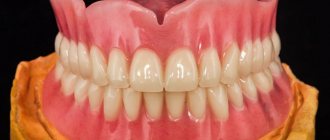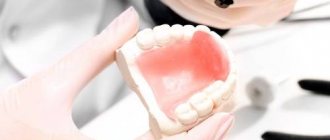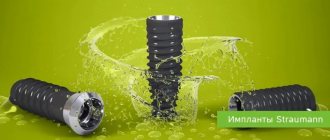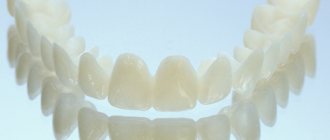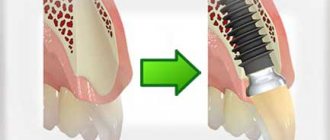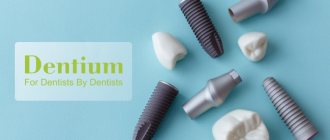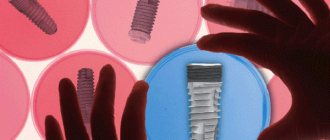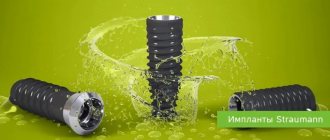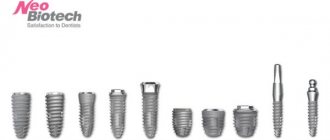When choosing dental implants, any patient asks the question – which ones are best to install? Indeed, despite the fact that modern implantation systems are similar to each other, they have significant differences.
Recently, much attention has been paid to the surface of implants. What is this connected with? The strength properties of the implant and how the denture will interact with the implant, and the implant itself with bone tissue, depend on it. This is why today many dentists and patients choose Snucone implants with an SLA surface. This is an innovative product in implantology, combining advanced achievements and allowing to accelerate the process of bone formation on the surface of the implant. Simply put, dental implantation using these implants allows you to speed up the healing process and make it more comfortable.
The history of Snucone implants
In Russia, the name of the South Korean company Snucone is not a household name, but this company has existed since 1997 - not every dental company can boast of such a long history.
In 2005, together with German colleagues, the company began producing implants. At first they were sold only in Korea, but in 2011 the company signed agreements with Italy, China, Iran and the Russian Federation - the implants entered the international market and were warmly received by the dental community.
Snucone appeared in our country not so long ago, so in order to get as much useful information as possible, Astghik Arutovna Muselimyan, an orthopedic dentist, surgeon, implantologist, who holds the position of chief physician at the Moscow dental clinic Smartline, answers patients’ questions.
Question to the dentist:
Why do you use Snucone implants?
I have been working with Snucone implants for over 7 years. Patients implanted at the Smartline Clinic are constantly monitored, visiting us twice a year, during which I conduct an examination and take x-rays to assess the condition of the implants. The results that Snucone implants show simply amaze me. Despite their long service life, the tissue around them remains stable and does not collapse.
Advantages
The main idea of the Korean Snucone implants is to combine the advantages of dozens of other implantation systems in one design. When the company signed an agreement with German specialists in 2005, it received the opportunity to use several technological innovations. Thanks to this, Snucone implants have the following advantages:
- Survival rate in 98% of cases . Such a high percentage was confirmed during a five-year study at the Department of Oral and Maxillofacial Surgery in South Korea, that is, this is not a theoretical, but a very specific figure.
- Long service life . Clinical observations show that Snukon implants behave absolutely stably, without causing changes in surrounding tissues for ten years or more.
- No inflammation . The most common cause of implant failure is bacteria entering the jawbone. Thanks to the special connection between the implant and the abutment (the connecting link between the implant and the crown) in Snucone designs, the chance of inflammation is reduced to almost zero.
- Stable immediately after installation . Due to the tapered design, when placed in soft bone, it is compacted, thereby achieving primary stabilization. It can usually be replaced with a temporary crown immediately, so you never have to go a day without a tooth.
- Quick installation . Due to the fact that the implants have a double thread, rapid and non-traumatic immersion into the bone occurs.
- Affordable price . There are many more expensive systems on the market, but Snucon implants are in no way inferior to them, and at the same time keep the price at an affordable level due to a special South Korean approach to production.
Question to the dentist : For which clinical cases are Snukon implants best suited?
Snucone implants can be used in any clinical cases, thanks to the availability of implants of different designs in the arsenal.
For example, in the posterior part of the upper jaw, where the maxillary sinus is located, there is often little bone in height and it has a loose structure, so traditional implants cannot be installed without bone augmentation. Snucone specialists have developed short implants with a unique design that are easily fixed in such conditions and show excellent results.
If the width of the jaw bone is insufficient, the ridge splitting technique is often used, in which implants are simultaneously installed.
When using conventional aggressive implants, the bone often breaks and causes complications. Conical implants created by Snucone can be placed completely safely in clefts, maintaining the integrity of the bone walls and achieving excellent stability.
The most common complication of implantation is bone destruction at the neck of the implants. The neck is the part of the implant located closer to the surface of the bone. Destruction occurs due to a lack of bone volume in this area, so when installing implants, bone is often built up. In such operations, it is definitely important that the bone material is firmly fixed in the area of the implant neck. This important factor is also taken into account by Snucone specialists. The taper and smooth design of the neck of the implants allow the bone to be retained in this area and its growth to be achieved.
Implantation and prosthetics All-on-4 (methodology)
We talk in detail about the features of the surgical stage in another article, but in short, there are 2 options for the surgical technique. The first option is using an individual surgical template “NobelGuide”, thanks to which the installation of 4 implants will take the implant surgeon only 30-35 minutes. The second option is a classic technique without the use of a template, which requires incisions in the gums and large-scale detachment of mucoperiosteal flaps. Of course, the first option is preferable.
All-on-4 (implant installation stage) –
I would also like to dwell on the choice of implants for the All-on-4 technique, and by far the best choice would be to use original implants. This company has developed not only the “All-on-4” concept itself, but also special types of implants and abutments for it. We are talking primarily about the Nobel Speedy Groovy and Nobel Parallel CC implants, as well as aba (multi-unit), which today are the gold standard for permanent prosthetics of edentulous jaws.
Next we will look at:
- options for temporary fixed prostheses for All-on-4,
- options for permanent fixed dentures on 4 implants.
Design features of Snukon implants
All of the above advantages are possible thanks to the design features of Korean Snukon implants. Classic features are the root-like shape and the use of an abutment for a better connection to the crown. But this applies to almost all implants, so Snucone also has more original solutions.
Rough surface for quick healing
In 1998, dentists developed the SLA surface, which was a real breakthrough in implantation.
It turns out as follows:
- The titanium root is treated with an abrasive jet, which roughens the smooth surface.
- After treatment, the implant is washed and etched with acid, which creates microscopic pores.
- Finally, the acid is neutralized and thoroughly washed off, and the finished implant is sterilized with gamma rays and packaged in a sealed container.
Why should the implant surface be porous? The fact is that the bone simply cannot grow normally to a smooth surface. But in the smallest pores, the bone tissue will grow very quickly, since it will have something to cling to - this ensures engraftment in 3-4 months. For comparison, previously implants took at least six months to take root, and during this time it was not even possible to put a temporary crown on them.
Special thread for strong fixation
Many modern companies produce implants with single threads. But Snucone uses double thread technology.
Why is double thread needed? This design makes it faster and easier to screw in the implant. The double thread causes less damage to the bone and at the same time allows the implant to immediately hold tightly in the jaw so that a temporary crown can be placed on it.
Another feature of the Snucone implant thread is its square section. Several studies were conducted in South Korea that showed that such a thread better distributes the chewing load and minimizes bone loss, which means it increases the service life of implants several times.
Cone-shaped connection with anti-inflammatory abutment
An abutment is an element that connects the prosthesis and the implant. The connection between the abutment and the implant is a vulnerable point - infection can easily enter the bone through it. This will cause inflammation, called peri-implantitis, and cause implant failure.
To prevent inflammation from occurring, Sucone implants use a special connection - a Morse taper, which allows the abutment to wedge into the implant, creating a tightness.
Switching platforms to preserve bone and gums
Many modern implants have a problem - over time, the gums and bone at the very edge of the crown begin to decrease, which is why the abutment or neck of the implant becomes visible. This spoils the aesthetics, especially in the smile area. This happens because the thickness of the soft tissue around the implant is much less than around a natural tooth.
To avoid this, Snucone implants use platform switching. This is a special technology in which the abutment is less wide than the width of the implant, and expands only to the point of connection with the crown. The narrow part of the abutment allows you to create a large natural volume of gum around it and prevents tissue loss. For the patient, this means that his artificial teeth will look natural for decades.
Implants made of pure titanium
The Snucone company uses only medical grade 4 titanium in its products, which is completely hypoallergenic and safe for the body.
Positive and negative points
The main advantages of this model range are the following qualities:
- Slight risk of possible rejection. According to statistics, designs take root in 98% of all cases.
- Long service life. Proper care and periodic dental examinations ensure comfortable wearing for more than 10 years.
- Minimal chance of developing inflammatory processes due to the complete covering of the implant insertion site by the abutment.
- Complete implantation into the jaw prevents destruction of bone tissue , and evenly distributes the load during the act of chewing.
- The products can be used in completely edentulous teeth.
- Low cost compared to similar designs from other brands.
The negative aspects include the limited information on statistical data. This is due to the fact that these products have been used in Russia only for the last 10 years.
Also, for a certain category of the population, the price of the Snukon orthopedic product can cause financial difficulties.
The best models of Denti System implants and their purpose.
Come here if you are interested in the features of Green implants.
At this address https://www.vash-dentist.ru/implantatsiya/proizvoditeli/assortiment-radix-belorussii.html you will find objective reviews about Radix implants.
Indications for implantation
Implantation of Snucone is indicated in the following cases:
- The absence of one tooth in the dentition. A tooth can be lost a long time ago or removed right before implantation.
- Absence of all teeth on the jaw.
- Missing several teeth in a row - you can install a bridge on several implants without grinding down healthy teeth.
- The need to place an implant simultaneously with bone grafting.
- Desire to place a temporary prosthesis immediately after implantation.
Question to the dentist : Is it possible to place Snukon implants on older people or teenagers?
Dental implants can be placed starting from the age of 19 for girls and from the age of 20 for boys. At this age, it is first necessary to take an x-ray of the wrist joint and monitor the completion of bone formation from cartilage.
Old age is not a reason for refusing implantation to people if there are no general health contraindications.
Benefits of Snukon implantation
The following advantages of Snukon implants follow from the design features:
- Survival time of three to four months thanks to the SLA surface, anatomical shape and double thread.
- Reduced likelihood of inflammatory complications and rejections - access to the implant shaft is completely blocked by the abutment.
- Thanks to the drill included in the kit, installation takes place in less than an hour, so you don't have to sit in a chair for a long time.
- Double thread and the ability to install entirely into the bone allows you to distribute the load on the bone more evenly for faster healing and less loss.
- A wide range of models allows for classic and one-stage implantation, as well as placing implants simultaneously with bone grafting or splitting the alveolar ridge - you just need to select a rod of the appropriate length and diameter.
- Low price compared to other implants from European, South Korean and Israeli companies.
Implant models
Snucone today offers two series of implants.
Abiding Fixture Plus I
This series is designed for installation in soft bone (as a rule, this is the bone in a person’s lower jaw). Their diameter ranges from 3.5 to 6.8 mm. Models with a diameter of 3.5 and 4 mm can be installed together with an alveolar ridge split. Wider implants are suitable for installation in the sockets of lateral teeth immediately after their removal. The length of implants in this line is from 7 to 14 mm, selected depending on the condition of the patient’s bone tissue.
The AF+I series implants provide good compaction of soft bone and can be immediately fitted with temporary crowns.
Abiding Fixture Plus II
This series is intended for implantation into high-density bone. The stability in it is usually high in itself, but such bone decreases much faster due to load, so AF+II implants distribute it much better within the tissues.
The diameter of the implants ranges from 3.5 to 4.8, the length also from 7 to 14.
Additional components
In addition to the implants themselves, the Snukon company offers plugs, gum formers and abutments of various shapes and sizes: straight, angled, screw, spherical, etc.
Reviews from patients and comments from specialists
Despite the fact that the Snukon company has just begun to conquer the Russian market of dental products, many positive reviews have been left about its product line, both among patients and from practitioners.
The low cost compared to other branded products causes approval among patients. And the design features and low rejection rate make them popular among practitioners.
You can leave your reviews and comments under the article.
If you find an error, please select a piece of text and press Ctrl+Enter.
Tags implantation implant manufacturers
Did you like the article? stay tuned
Previous article
Create a Hollywood smile quickly and inexpensively with Snap on Smile veneers
Next article
Purpose and types of dental sockets
How is implantation performed using the Snucone system?
Implantation is a full-fledged surgical operation, although visually it seems insignificant. It requires lengthy preparation and consists of several stages.
Preparation for implantation
It all starts with the first visit to the dentist. The patient, together with the doctor, selects the appropriate type of implantation; the doctor takes an x-ray and selects implants based on the condition of your bone tissue. Also at this stage, the patient is sent for tests to make sure that he does not have HIV, diabetes or other serious diseases in which implantation is contraindicated or must be performed with extreme caution.
After the implantation technique has been chosen, it is necessary to sanitize the oral cavity - fill carious teeth, relieve gum inflammation, etc. This is necessary to ensure that there are no pockets of inflammation in the mouth, bacteria from which can adversely affect the implant’s healing.
The duration of this stage depends on the condition of the oral cavity and can take either a week or a month.
Bone grafting
This is an optional, but often necessary stage of implantation. The fact is that if a tooth is lost a long time ago, the bone tissue gradually decreases. As a result, the bone becomes too thin - there is simply no room left for the implant. To create the required volume of bone, you have to replant it separately. In some cases, bone tissue growth can take 3-4 months - and during this time you will have to walk without implants.
Snucone implants sometimes allow implantation to be performed simultaneously with bone grafting, such as a sinus lift (bone grafting in the upper jaw) or ridge augmentation (splitting) (if the bone is too narrow).
The implantation itself
Implantation itself is the shortest stage, which takes only 30-60 minutes. It is divided into several more separate steps:
- The patient sits in the dental chair, the doctor gives him anesthesia. Modern anesthetics allow you to completely avoid pain during implantation.
- The doctor makes a puncture on the mucous membrane, then drills out the bone using the drill included in the kit.
- An implant is implanted into the resulting hole.
- If necessary, several implants can be installed during one operation. The gum is sutured to stop bleeding.
- Abutments or gum formers, and sometimes temporary crowns, are installed on the implants.
After the procedure, the patient can go home immediately.
In some clinics, implantation is done using surgical templates. These are special overlays for the patient’s jaw, in which holes are made for implants. The onlays are made based on a computer model and allow you to install the implants as accurately as possible and at the desired angle.
Question for the dentist : How long does implantation take using the Snucone system?
The operation to install one implant takes on average 20-30 minutes. To a large extent, this depends on the precise planning of the operation. Before implantation, it is important to undergo X-ray diagnostics - take a panoramic image or computed tomography and accurately calculate the direction of implant installation, as well as select the correct diameter and length of the implant, assess bone density and select an implant of the required design. And of course, the speed and success of the operation depend on the experience and manual skills of the surgeon.
Implant healing
This is more likely not a stage, but a forced pause in implantation. During the healing period, the patient can walk with a temporary crown and lead a normal life, periodically visiting the dentist for examination. The stage lasts 3 – 4 months depending on the condition of the patient’s bone.
Question to the dentist : Is it possible to use Snukon implants in one-stage and one-stage implantation?
Immediate is the immediate installation of an implant into the socket of an extracted tooth. Typically, this technique is used in the anterior part of the jaws, where there is a need for one-stage prosthetics with a temporary crown. Snukon engineers have developed implants for installation in the socket of extracted teeth. They have a tapered shape and a specific thread design that allows for excellent implant fixation even with a small amount of bone. The rough surface of Snukon implants, similar to the bone structure, allows the implants to integrate quickly and predictably, including during immediate implantation, when the implant is fixed only at the tip, and its main surface does not have contact with the bone.
Prosthetics
When the implant has completely taken root in the jaw, it will no longer be possible to install a light plastic one, but a full-fledged prosthesis. To do this, the patient comes to the clinic, where impressions of his jaws are taken. After this, a crown is made in the laboratory, which is fixed to the implant with special cement.
When a permanent prosthesis is installed in a patient, the implantation can be considered completely completed. A person receives a full-fledged artificial tooth, which is visually and functionally no different from the real one.
Question to the dentist : How long do Snukon implants actually take to take root?
Since the bone has different densities in different parts of the jaws, the healing time of the implants is different. In the lower jaw, where dense bone is typically found, integration takes an average of 3 months, while in the upper jaw it takes 4.5 months due to the softer bone structure.
Question to the dentist: Is it possible to immediately install temporary dentures on them so as not to go without a tooth?
In aesthetically important areas, a temporary crown is installed on the implant immediately. Typically these are front teeth that require immediate aesthetic restoration.
It is also possible to place temporary crowns when three or more implants are combined. For example, when we install six implants on the lower jaw with complete absence of teeth, we immediately make a removable or bridge-like temporary prosthesis, fixing it on these implants.
Question to the dentist : What dentures can be placed on Snukon implants?
The Snukon system has orthopedic components that allow prosthetics to be performed in accordance with the highest world standards. The presence of titanium bases makes it possible to produce screw-retained crowns and avoid cementing the crown in the oral cavity, since the presence of cement residues on the surface of the crown or implant causes inflammation and tissue destruction. Components are also available to enable the production of individual abutments. An abutment is an intermediate link between a dental implant and the tooth crown. An abutment is called a custom one because it is made based on the shape of the gums around the implant. Such an abutment allows you to obtain an exact fit to the gum and avoid its sagging, ensuring long-term tissue stability.
Also, the Snukon system has all the necessary components that allow for high-quality prosthetics with removable and non-removable structures on implants.
Temporary fixed dentures on 4 implants –
Let's see how the temporary prosthetics stage is carried out. To do this, impressions of your jaws will be taken before surgery to make a complete removable denture from ordinary acrylic plastic. After the operation, a temporary prosthesis on 4 implants will be made from such a removable prosthesis. To do this, the excess volume of the plastic base and excess artificial teeth will be cut off from the removable denture (the temporary denture is usually short in length - 5 teeth inclusive).
Permanent fixed dentures on 4 implants are usually made in length - up to 6 teeth inclusive. However, temporary dentures are always made shorter in length in order to reduce the chewing load on the lateral implants (this is necessary during the period of their healing). In addition, a screw fixation system on implants is built into the temporary prosthesis, as well as an optional metal frame (Fig. 9-10). Thanks to this frame, the temporary prosthesis gains strength, and then it can be used for up to 3 years. But on the other hand, this will significantly increase the cost.
Converting a removable denture into a fixed bridge –
Thus, before concluding an agreement with the clinic, you will need to choose - 1) the manufacturer of dental implants, 2) the type of temporary fixed prosthesis, which can be either with or without a metal frame. The presence of a metal frame in the adaptive prosthesis significantly increases the cost of All-on-4.
- Example No. 1 – implantation according to the All-on-4 protocol for 400,000 rubles (the price includes the installation of 4 Swiss Nobel Biocare implants, multi-unit abutments, as well as a temporary adaptive bridge on a metal frame).
- Example No. 2 – implantation according to the All-on-4 protocol for 300,000 rubles (the price includes the installation of 4 Swiss Nobel Biocare implants, multi-unit abutments, as well as a temporary adaptive bridge without a metal frame).
1) Temporary bridge with metal frame –
This prosthesis option is the best not only because you can use it for up to 3 years (before you need a replacement prosthesis).
It must be remembered that a temporary fixed prosthesis will be made from a regular plastic removable denture, and by sawing off the excess plastic base from a removable denture, we further reduce its strength. The metal frame will give the temporary prosthesis high strength and reliability (Fig. 9-10). To install the frame, a piece of plastic is also cut out on the lower surface of the prosthesis - and a metal frame + a system for screw fixation of the prosthesis on implants is built in there. Embedding a metal frame into a prosthesis is a very complex and time-consuming procedure, which is why the presence of a frame in the prosthesis has such a big impact on the cost of the All-on-4. Thanks to the reinforced frame, the risk of breakage of such a prosthesis is minimal, and you can chew with it without fear.
2) Temporary bridge without frame –
If a temporary prosthesis with a metal frame is fixed to implants only for 2-3 days, then a prosthesis without a frame is fixed within a few hours after the operation. This is due to the ease of manufacturing of the latter. The main disadvantage of this version of the prosthesis is its low strength and, accordingly, reliability. Prostheses without a frame are not intended to be used for more than 5 months, and even during this not too long period there is a risk of breakage of such a prosthesis.
Let's see what types of patients would be contraindicated for a temporary bridge without a frame. Definitely not suitable for men under 50 years old, as well as patients with large jaws and well-developed masticatory muscles at any age. In addition, if you have bruxism (hypertonicity of the masticatory muscles), and here it should be noted that patients with bruxism are remarkably good at breaking dentures even with a metal frame (24stoma.ru). If you are going to chew something harder than porridge and rolled cutlets.
Definitely, the option of a prosthesis without a frame is not suitable for those patients who, due to work or other circumstances, may go to another city (for example, on vacation or a business trip). The fact is that if a prosthesis breaks down in another city, and you cannot immediately contact your implantologist, this is fraught with the loss of not only the prosthesis, but also all the implants. Therefore, a temporary bridge should ideally always be made with a reinforcing metal frame. The risk of breakage of a prosthesis without a frame will probably be minimal - only in women with small jaws.
Patients with temporary (adaptive) prostheses –
Clinical case No. 1 –
Clinical case No. 2 –
Care and maintenance of adaptive prostheses –
In addition to daily hygiene care using a irrigator, floss and toothbrush, your denture will require periodic professional maintenance. On average, once every 6 months (if oral hygiene is insufficient - once every 3 months) - you will have to go to the clinic for hygienic cleaning of the lower surface of the denture. To do this, the screws that secure the prosthesis to the implants will be unscrewed, and the prosthesis itself will be temporarily removed from the mouth.
Immediately after the procedure is completed, the prosthesis will again be fixed to the implants using screws. In addition, these screws will need to be replaced once a year (during every second procedure for professional hygiene of the prosthesis). Therefore, it is worth clarifying in advance whether professional servicing of the prosthesis is included in the list of free procedures under the warranty, and how much it will cost after the end of the warranty period.
Video of All-on-4 implantation and prosthetics:
* this video contains the stages of making a temporary (adaptation) bridge.
Rehabilitation after implantation
We have already seen that implantation is a serious surgical operation. Therefore, after it the patient will need to go through a recovery stage. Fortunately, Snookon implants are installed with minimal trauma to the gums and bone, so recovery is usually easy.
In the first few days, the patient may experience pain, the gums become swollen and red. The dentist prescribes antiseptic rinses, painkillers and anti-inflammatory drugs, and cold compresses. If you follow the doctor’s recommendations, then after 3-4 days the pain will completely disappear and the swelling will subside. The recommendation is written in the passport that the patient receives after implantation.
But this will not be the end of rehabilitation. In order for the body to recover, within a week after the procedure you should not:
- Taking hot baths, going to the sauna and bathhouse, sunbathing in the open sun - due to high temperatures, wounds heal worse, bleeding may open and inflammation may develop.
- Subject the body to strong physical stress.
- Brush your teeth intensively in the area where the implant is installed.
Also, it is not recommended to chew solid food (nuts, crackers, etc.) while wearing the temporary crown.
Prosthetics on Snukon implants
Thanks to the wide variety of abutments, South Korean Snukon implants can be used to install almost any prosthesis.
Most often, patients are concerned about the loss of one tooth; in this case, the dentist installs a single implant with a crown. The crown can be made of different materials:
- Metal ceramics . Inexpensive and quite durable option, quite suitable for chewing teeth. Unfortunately, due to the opaque frame, such teeth look unnatural and will look bad in the smile area.
- Solid ceramics . A very aesthetic material with natural transparency and the ability to create smooth color transitions, like a real tooth. It is slightly more fragile than metal ceramics, so it is not suitable for installation on chewing teeth. But it looks great on the incisors and canines in the smile area.
- Zirconium dioxide . The most expensive material, both aesthetic and durable. Unlike metal ceramics, it never causes allergies, does not lose aesthetics over time, and lasts almost as long as implants. Suitable for both front and back teeth.
In addition to a single crown, a bridge can be placed on Snucone implants. If several teeth are missing in a row, two implants are placed at the edges of the defect, and several interconnected crowns are fixed on them. You can also implant several implants at once and put new teeth even on a completely toothless jaw.
How long do dentures on implants last?
The service life of an artificial structure depends not only on the implant, but also on the material of the prosthesis. The lining of metal-ceramic crowns chips off over time, so they require replacement after 4 to 5 years. With proper care and gentle handling, ceramic crowns last longer, but can also chip or crack. Zirconium dioxide crowns are very durable and typically last at least 10 years.
Implants have a longer service life than dentures. With proper oral hygiene and quitting smoking, even 10 years is far from the limit. If the prosthesis breaks, the implant will remain in the jaw, and another structure can easily be placed on it.
Permanent prosthetics All-on-4 – price and options
All-on-4 permanent dentures can be achieved with different types of permanent fixed dentures. There are a lot of options for permanent prostheses for All-on-4, and it is very difficult for an ordinary patient to understand all their subtleties and nuances. In addition, the choice of prosthesis is determined not only by your aesthetic requirements or financial capabilities, because... In a number of clinical situations, some types of prostheses simply cannot be manufactured.
In addition to the patient’s wishes, the choice of prosthesis will depend on the volume of space for prosthetics (the degree of vertical atrophy of the jaw bone tissue), as well as on the characteristics of the relationship between the upper and lower jaws. For a permanent fixed denture on 4 implants, the price in Moscow and Russia as a whole starts from 150,000 rubles, and this will be the most modest and not very reliable option for a permanent denture. It should be noted that in Russia, in order to reduce the cost of All-on-4, a number of clinics use materials and technologies that have long been abandoned in Europe due to their poor reliability.
Permanent denture options for All-on-4 –
We have already said several times that the All-on-4 technique was developed by Nobel-Biocare (Switzerland), including special types of implants and options for temporary and permanent dentures. In this section, we will first talk about the original options for permanent prosthetics that were developed by Nobel-Biocare, and then move on to a variety of options for prostheses (including non-original economy-class solutions specifically for Russia).
All types of original permanent fixed prostheses for All-on-4 can be divided into two large groups.
- Titanium-polymer prostheses - 90% of permanent prostheses for All-on-4 are made using this technology. Such a prosthesis has a supporting frame inside in the form of a titanium beam, individually manufactured for each patient - by milling on a computer-controlled machine (CAD/CAM technology). The outside of the beam is lined with acrylic plastic or ceramic composite, from which the base of the prosthesis (artificial gum) will be made + artificial teeth will be installed in the base of the prosthesis (Fig. 16-17).
If you are focused on quality, then it is better to choose original solutions - these are only titanium beams from Nobel-Procera, although non-original beams from other manufacturers can also be used (they will be a little cheaper). Modern beams are not made smooth - they have retention projections that act as supports for artificial teeth. The best option is probably the “NobelProcera hybrid beam”, which has no analogues from any company, not even Straumann.
But! Titanium-polymer prostheses require a lot of vertical space for prosthetics, and therefore, if the patient has only a slight degree of atrophy of the jaw bone tissue, these prostheses simply cannot be manufactured. In this case, we will offer the patient only bridges made of zirconium dioxide or metal ceramics.
- Bridges can be the familiar metal-ceramics or metal-free ceramics (zirconium dioxide). In both cases, the bridge frames will also be manufactured by milling using CAD/CAM technology. The original frame for a metal-ceramic bridge is made of titanium, the artificial teeth will be made of zirconium dioxide, and if artificial pink gum is needed, it will be made by applying a ceramic mass (Fig. 18).
The frame of the ceramic bridge will be made of zirconium dioxide, the artificial teeth will also be made of zirconium dioxide + if necessary, the prosthesis can also have pink artificial gum made of ceramic (Fig. 19). This is the best option for a prosthesis in terms of aesthetics, and in the photo below you can see how accurately it imitates the gums and teeth on the lower jaw, which are difficult to distinguish from real ones (Fig. 20).
Important: original All-on-4 prosthetics involves the use of only Nobel-Procera titanium bars and bridges. But it won’t be a problem if your clinic uses non-original milled frames made on similar equipment from other companies. But what’s really bad is when Russian dental clinics offer economical options for prosthetics, for example, when instead of a milled titanium beam, a cast beam made of nickel-chrome alloy is used. Or when metal-ceramics are made on a frame made of cobalt-chromium alloy (CHS), even by milling.
Such solutions make it possible to reduce the cost of All-on-4, but this reduces the strength of the prosthesis frame by at least 5 times, and in addition, the use of cast beams greatly impairs the accuracy of their fit on the installed implants. Another disadvantage is that cast nickel-chrome beams and CCS frames have a significantly greater mass (compared to titanium), which significantly increases the weight of the prosthesis and makes it difficult to get used to it.

